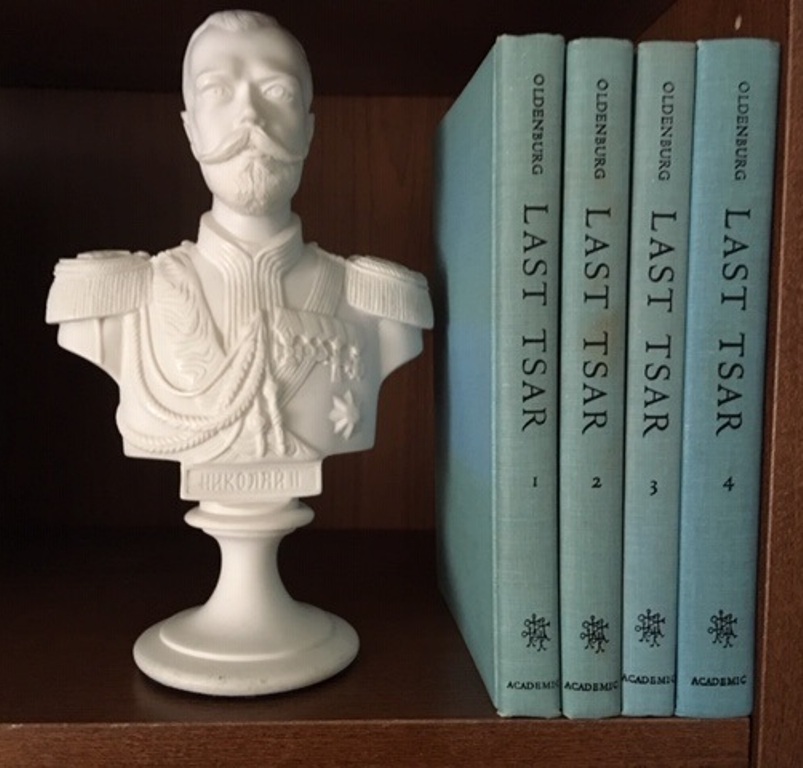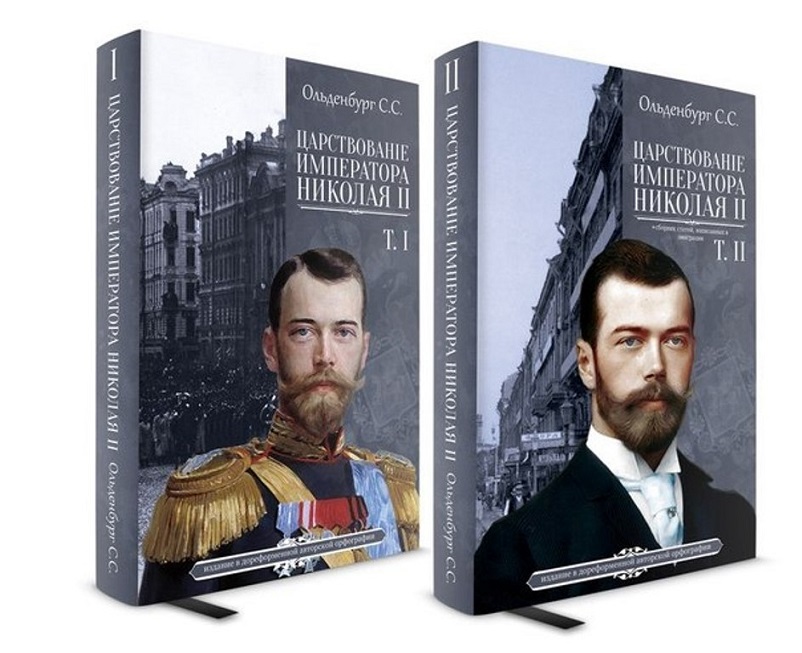
4-volume edition of Last Tsar. Nicholas II, His Reign & His Russia by S. S. Oldenburg (1975)
Photo © Paul Gilbert
I have been collecting books on Nicholas II now for decades, and there is nothing I enjoy more than a good book hunt! The title which I wanted most to complete my library was the English language 4-volume edition of Last Tsar. Nicholas II, His Reign & His Russia by the noted Russian historian and journalist Sergei Sergeiivich Oldenburg (1888-1940). This title has been out of print for many years now, however, several years back, I was able to track down a set in mint condition, through a Dutch bookseller for €75. This is the only study of Russia’s last emperor and tsar that I would recommend to any serious student of the life and reign of Russia’s last emperor and tsar.
It was the Supreme Monarchist Council[1], a monarchist organization created by Russian émigrés in 1921, who commissioned Oldenburg to write a comprehensive history of the reign of Emperor Nicholas II. The first volume which appeared in Russian, was published in 1939 in Belgrade (Serbia), and the second was not published until a decade later, and posthumously in 1949 in Munich (Germany). The first Russian edition published in Post-Soviet Russia was in 1991. Numerous reprints have been issued since.
The English language edition was published in 1975 by Academic International Press in Gulf Breeze, Florida. Of particular note is the 18-page introduction Searching for the Last Tsar by Associate Professor of History Patrick J. Rollins (now deceased) of Old Dominion University (est. 1930), a public research university in Norfolk, Virginia. As Rollins notes in the study’s preface:
“Oldenburg’s [ Last Tsar. Nicholas II, His Reign & His Russia] is a major document in modern Russian historiography. The final contribution of a Russian nationalist historian, it provides uniquely sensitive insights into the character, personality, and policies of Russia’s last tsar. It has no rival as a political biography of Nicholas II and is without peer as a comprehensive history of his reign.”
His comprehensive study of Nicholas II is apologetic in nature. Oldenburg substantiates that the revolution interrupted the successful progressive economic development of Russia under Nicholas II: “in the twentieth year of the reign of Emperor Nicholas II, Russia had reached a unprecedented level of economic prosperity”.
Oldenburg was able to undertake such a study of Russia’s last tsar, having had access to a unique collection of documents. These included copies of authentic historical acts of the Russian Empire held in the Russian Embassy in Paris on Rue Grenelle. Long before the First World War, duplicates of the originals had been made as a precautionary measure, and sent to the Russian Embassy in Paris for storage. In October 1917, the Provisional Government appointed Vasily Alekseyevich Maklakov (1869-1957), to replace Alexander Izvolsky as Russia’s Ambassador to France.
When he arrived in Paris, Maklakov learned about the takeover by the Bolsheviks. Regardless, he continued to occupy the splendid mansion of the Russian embassy for seven years, until France found it necessary to recognize the Bolshevik government. Fearing that the Embassy’s archival documents would fall into the hands of the Bolsheviks, Makloakov packed them up, including Oldenburg’s manuscript, the Okhrana archives, among other items and arranged for their transfer to the Stanford University.
Oldenburg’s fundamental historical research on the life and reign of Emperor Nicholas II, is sadly overlooked or simply ignored by Western historians.

Sergei Sergeiivich Oldenburg was born on 29 [O.S. 17] June 1888, in the town of Malaya Vishera, Russia. His father Sergey Fedorovich Oldenburg (1863-1934), was a famed academician (1900), and Orientalist specializing in Buddhist studies. He served as permanent secretary of the St. Petersburg Academy of Sciences (from 1904), Russian Academy of Sciences (from 1917), USSR Academy of Sciences (1925-1929), and Minister of Public Education (July — September 1917). His mother Alexandra Pavlovna Oldenburg (nee Timofeeva), was a graduate of the Mathematics Department of the Pedagogical Courses. She died in 1891.
He graduated from the law faculty of Moscow University, and later worked as an official in the Ministry of Finance of Russia.
Unlike his father, who adhered to liberal political views, Sergei from a young age adhered to right-wing views, a member the Union of October 17[2].
In 1918 Oldenburg went to the Crimea, where he joined the White movement. In the fall of 1920, he was unable to evacuate with the Russian Army, headed by General Baron P.N. Wrangel, because he was sick with typhoid . Having recovered, with fake documents, he travelled from Crimea to Petrograd, where he met his father, who helped him to emigrate.
He crossed the border into Finland, settling in Germany and then Paris, France, where he lived in poverty. Sergei Sergeiivich Oldenburg died at the age of 51, in Paris on 28 April 1940.

Russian language editions of Oldenburg’s study of Nicholas II have been issued since 1991
NOTES:
[1] The First Monarchical Congress, was held between 29th May to 6th June 1921, in the Bavarian restort town of Reichengal. The international congress of Russian monarchists in Germany, was intended to organize the activities of of monarchists both in emigration and in Russia (now the Soviet Union).
The congress was attended by 100 delegates from 30 countries, Metropolitan Anthony (Honorary Chairman), Archbishop Eulogius, Archimandrite Sergius, five senators, two army commanders, five members of the State Council, eight members of the State Duma, fourteen generals and many other statesmen. The chairman of the congress was Alexander Nikolaevich Krupensky (1861-1939).
During the Congress, the question of succession was declared untimely, since the possibility of saving the Imperial family was not ruled out. At the congress, the Dowager Empress Maria Feodorovna was recognized as the undisputed authority among Russian monarchists.
[2] The Union of October 17, commonly known as the Octobrist Party, was a political party in late Imperial Russia, firmly committed to a system of constitutional monarchy.
Founded in late October 1905, from 1906 the party was led by the industrialist Alexander Guchkov (1862-1936) who drew support from centrist-liberal gentry, and businessmen, who shared moderately right-wing, anti-revolutionary views. They were generally allied with the governments of Sergei Witte in 1905-1906 and Pyotr Stolypin in 1906-1911.
With the outbreak of World War I in August 1914, moderate political parties became moribund in Russia. By 1915, the Octobrists all but ceased to exist outside the capital, Petrograd. Several of its prominent members, particularly Guchkov and Mikhail Rodzianko, continued to play a significant role in Russian politics until 1917, when they were instrumental in convincing Nicholas II to abdicate during the February Revolution and in forming the Russian Provisional Government. With the fall of the Romanovs in March, the party became one of the ruling parties in the first Provisional Government.
Some members of the party later participated in the White Movement after the October Revolution and during the Russian Civil War (1918-1920), becoming active in White émigré circles after the Bolshevik victory in 1920. By that time, the October Revolution had given the term “Octobrist” a completely different meaning and connotation in Russian politics.
© Paul Gilbert. 26 March 2019
You must be logged in to post a comment.